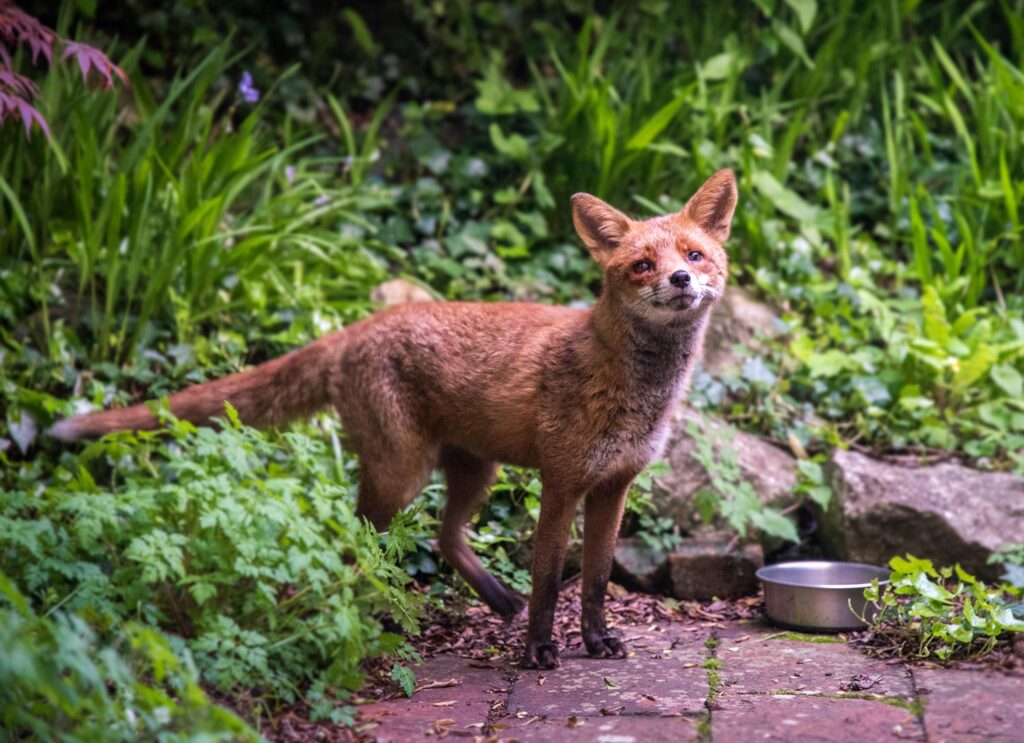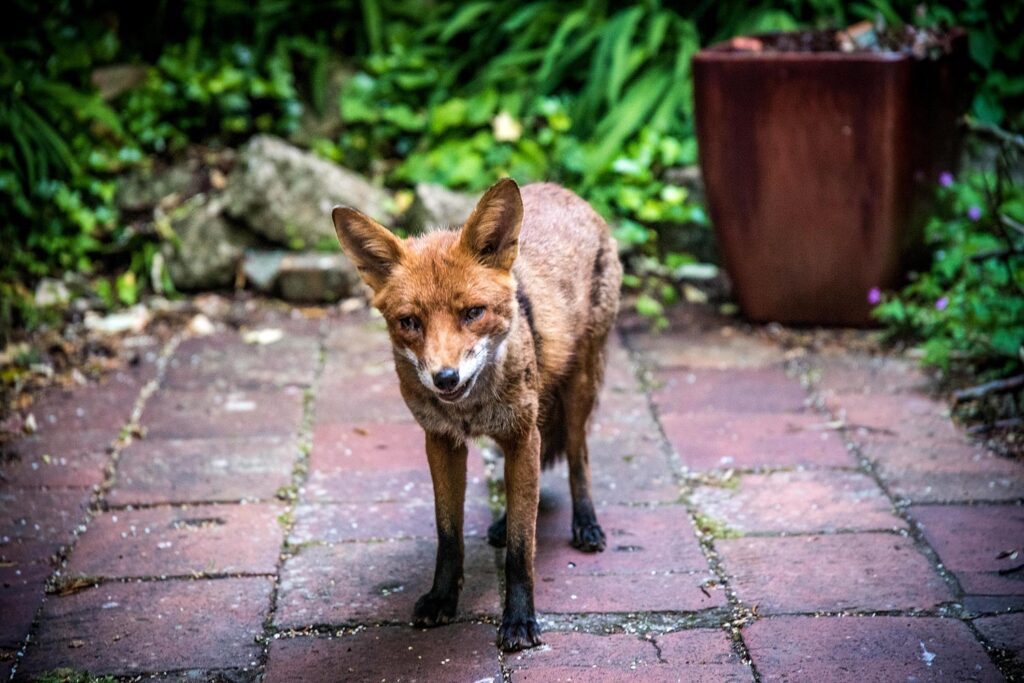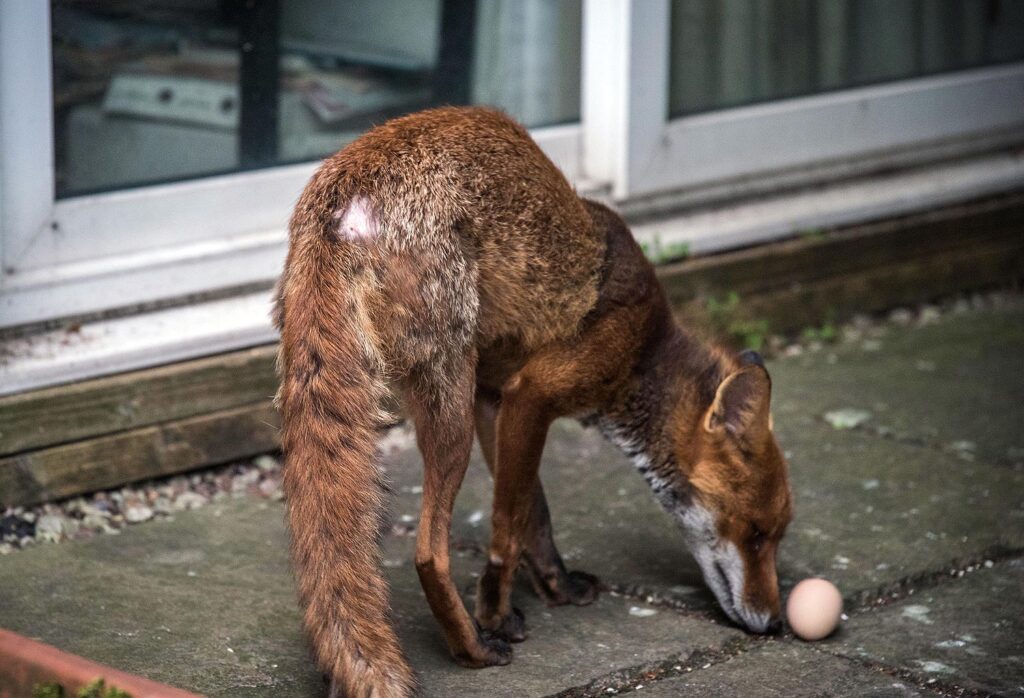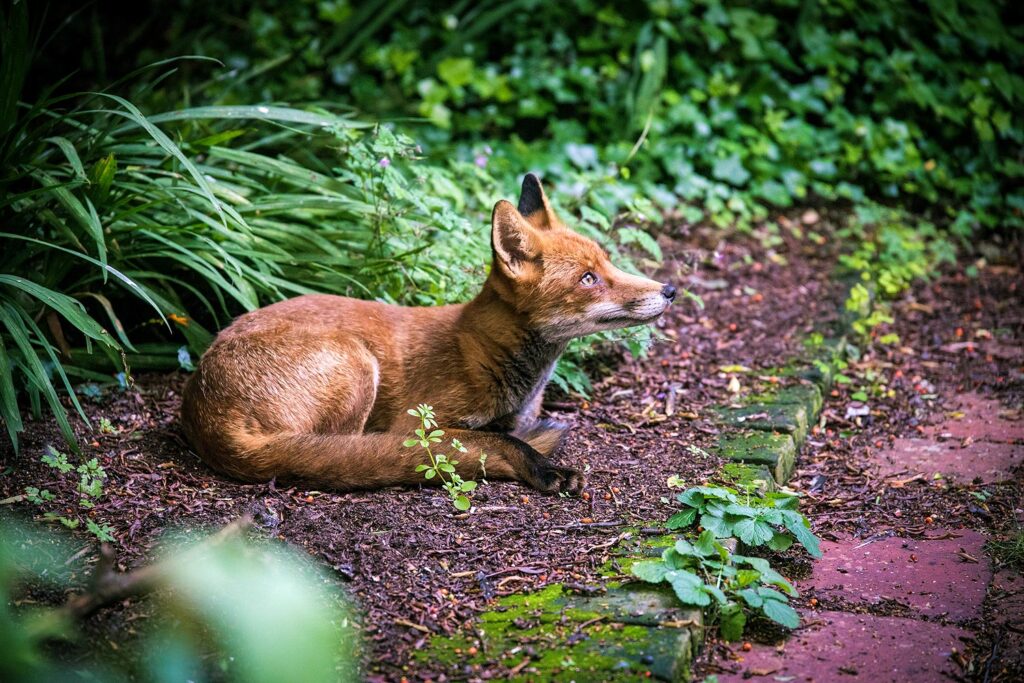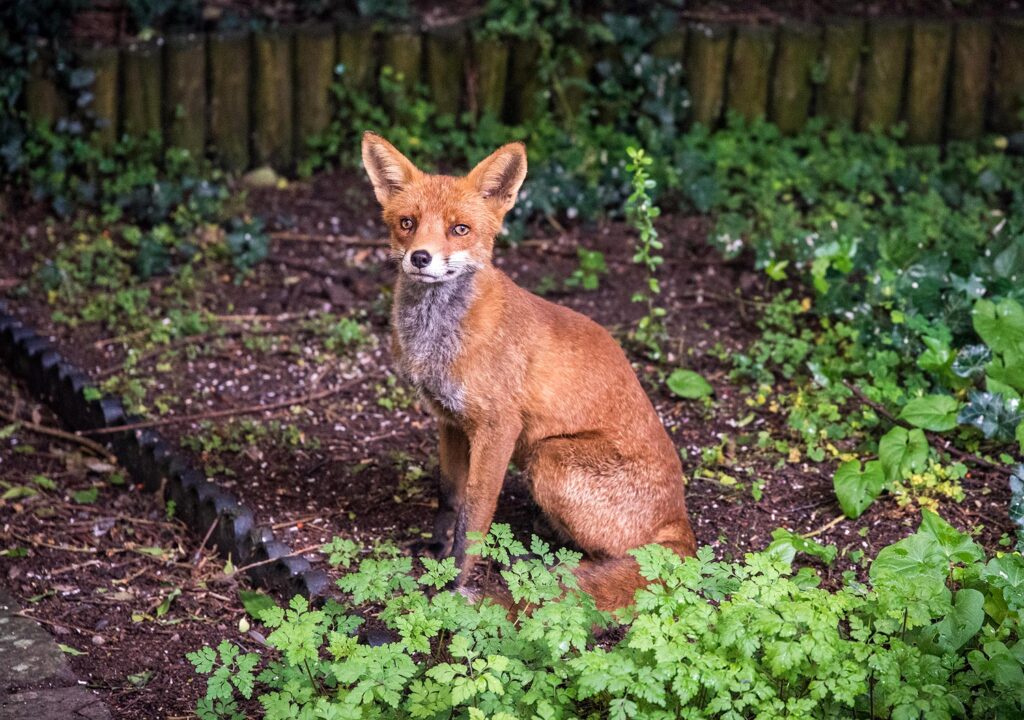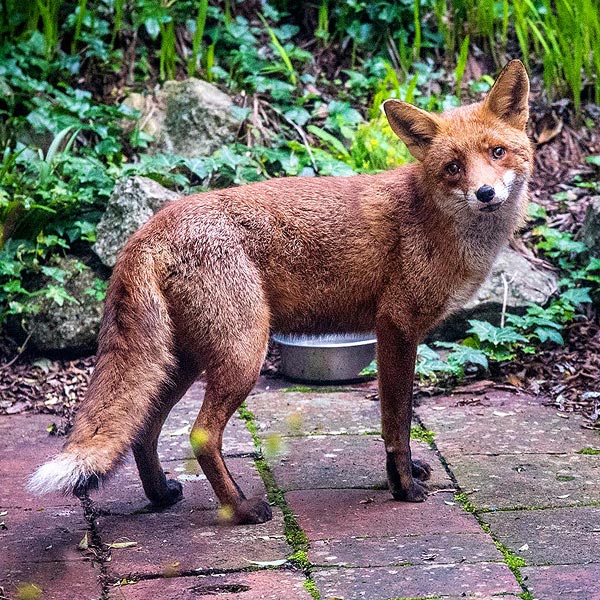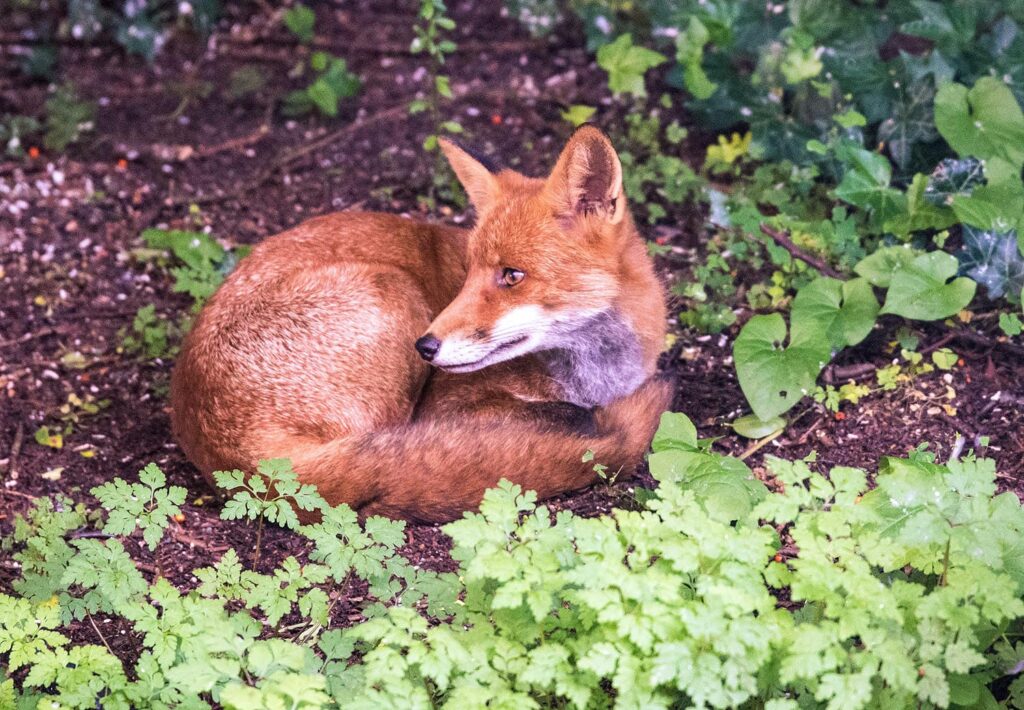A Bristol urban fox who chose me as his friend
This is a personal page that describes my growing relationship with one of Bristol’s urban foxes, something I regard as a rare and special privilege. I also cover some of the things I’ve learned as a result of getting to know this very charming young fox. We all live here together; we might as well get on.
I’ve lived in Bristol for many years and of course I’d heard about its urban fox population. In truth, Bristol isn’t really different to most other UK cities, and it seems that urban foxes are a feature of most of our towns and cities.
Despite Bristol’s notoriety for its red fox residents, for a long time I’d never even so much as seen one. I’d been a bit disappointed by that.
A couple of years ago that began to change. The very first intimation that there may be foxes in the area came with the discovery of a chewed up tennis ball in our garden. Initially I was quite perplexed by this, until it occurred to me that it may have been carried there by a fox. So I then set up a wildlife camera with infra-red night filming capability. And, sure enough, at my first attempt it revealed a nocturnally visiting fox family. I was enthralled.
Was my cat at risk?
A while later my elderly cat had taken to spending all her time sat in the garden. Sadly this was symptomatic of her progressively ailing health. But, because of this, I’d begun to routinely monitor the garden to check on her. And it was due to this – paying more attention to goings-on outside – that I first saw two young fox cubs (or kits) that were visiting the garden. At this stage they were clearly just motivated by curiosity.
Despite my excitement at witnessing these wild creatures up close I was, of course, concerned for the welfare of our cat and whether she might be at any risk from attack by the foxes. I’ve more to say about whether foxes might be a danger to domestic cats, which I’ll get to presently (short answer, they really aren’t) but I was quickly reassured by watching these two species together in the garden. Neither cat nor foxes seemed to be remotely concerned with each other; they’d appear to happily coexist in the small-ish garden. In fact, the cat’s stoic lack of interest – or even any response at all – seemed to assert her authority and the foxes appeared to recognise that, keeping a respectful distance.
So I began to put out food. Not too much, initially mostly a few dog biscuits, together with a bowl of water. But even these meagre pickings seemed enough to send out a message that this was a fox-friendly garden. Still watching from a distance, although increasingly sitting outside in the garden at the same time as them, the foxes would visit regularly in early evening.
Sadly, Misty the cat left us in July 2022, eventually overcome by that frequent feline issue of kidney failure, aged 18. We all miss her; even the foxes do, I think.
Bold Fox and Shy Fox
During the winter of early 2023 one fox in particular had become a daily regular and was also becoming noticeably tolerant of me. As mentioned, there seemed to be two foxes visiting, one becoming more fearless around me, while the other remained distinctly aloof and staunchly unprepared to trust me. This was when their respective names were decided; I now call them Bold Fox and Shy Fox. Bold Fox is male, Shy Fox female.
I began to vary the food that I provided, offering some more appealing items like raw egg and, rather poignantly, cat food, as we still had quite a stock of this.
Well, this is strange
My relationship with Bold Fox blossomed quite quickly. I do recall the day that I was sitting on the garden bench and Bold Fox came and stood about 10 feet away and just regarded me. Although he’d clearly been aware of me previously this was the first time he’d really chosen to engage with me. I distinctly felt like he was checking me out. Perhaps he’d decided to make a judgement about whether I was to be trusted. I must have passed that test because after that he would approach me more often. This would now involve eye contact and a curious head-bobbing action that I’ve still yet to fully understand but appears to be some kind of attempt to communicate.
Bold Fox is now a daily visitor. Shy Fox shows up too, every few days, but whilst she clearly knows who I am she is reluctant to approach or engage with me, other than to remain nervous and at a distance in my presence.
The mange infection
All this continues to be a learning process and, back in April 2023, I found myself having to learn about mange. This is a grim illness and of course one of the things that foxes are specifically vulnerable to. No sooner had I started to build a relationship with Bold Fox than I noticed he’d begun to look scruffy and lose fur from the base of his tail, together with bouts of furious scratching. It didn’t take me long to discover what this was and that it could actually be a fatal problem.
Did the fox come to me for help? Impossible to say, of course, but yes, I think maybe he recognised that I could be an ally. Once I understood the seriousness of what was afflicting him I knew I had to try to treat it.
Mange caused a bald patch at the base of Bold Fox’s spine. His fur was also becoming crusty and matted. This was one of the photos I supplied to the vet to confirm the infection.
Mange is a parasitic skin infection. Essentially these are tiny mites that burrow into the skin and once there begin to multiply, using the animal as a host. The result is intense discomfort, provoking itching and gnawing, which is what causes the progressive fur loss. The fur itself also begins to take on a crusty, lacklustre sheen. Left unchecked the animal’s health will rapidly deteriorate and it will likely prove fatal. It’s nasty and treatment is one of the things that a sympathetic human can help them with.
Mange can affect domestic dogs too, so there are anti-parasitic medications available (such as NexGard, Bravecto, & other brands). The good thing about these is that they are administered as one single tablet, easily mixed into food, and apparently pleasant enough to taste. My own experience is that they are highly effective, eliminating Bold Fox’s mange in just 21 days.
Prescription only
The problem is, in the UK at least, these medications are prescription-only. Notionally a vet can only prescribe to an animal ‘under their care’, which usually means they would need to examine the animal in person. Obviously, with a wild animal, this is rarely practical.
Fortunately, there are regulations designed to cover livestock that do permit prescription if photo or video evidence can be provided. The vet would also need the reassurance that the animal could be reliably target-fed and that no other animal could accidentally consume the tablet. If you can find a sympathetic vet – which I was lucky enough to do – then this is a totally reliable treatment. I learned this after much online research, eventually finding some helpful advisors who were able to guide me towards a solution (thanks Somerset Wildlife Rescue https://www.secretworld.org/).
At the time of writing (August 2023) the NexGard treatment cost £18.
After just one month the NexGard tablet had completely cleared the mange and Bold Fox’s coat was restored to its natural beauty. I wonder if he realises how lucky he’s been!
Homeopathic mange remedy
If the pharmaceutical option isn’t available then the alternative is a homeopathic remedy. I’ve not tried this myself but there are some respectable and authoritative commentators who claim a solid success rate for this. You can obtain the homoeopathic mange treatment here:
https://www.petperfection.net/product/homeopathic-mange-treatment-for-foxes/
The main issue with this is that it requires a long-term daily dosing, which may not always be practical. However, apparently it’s harmless to all wildlife, so no worry if it should be eaten by someone other than the intended recipient.
I put together a kind of video diary of Bold Fox’s mange treatment, mainly to keep the vet advised of her patient’s progress. Also a brief appearance from Shy Fox in this short movie.
The spring moult
One thing I’d add is that foxes do have a winter and summer state to their fur. A fox may appear scruffy in the early part of the year when they’re shedding their thicker winter fur. So if your fox is looking a bit rough don’t necessarily jump to the conclusion that it’s mange. If it is a mange infection it’ll become clearly apparent soon enough.
This has become a frequent sight from the kitchen window. Bold Fox visits every evening and will sit in the garden and wait for me to notice him. I’ll give him a little food and then sometimes we’ll just hang out together.
Cat vs fox – no contest!
The domestic cat is a highly developed predator with an armoury of deadly techniques – speed, lightning reflexes, sharp claws and the ability to lash out with those claws. A cat is able to strike at a fox in a way that the fox has no response to. Yes a fox can bite, but it’d be near impossible to even get close to biting a cat. Cat claws cause serious injury and the fox knows it. It would be a desperate and foolhardy fox that took on a domestic cat. It’s not even a contest; you just don’t mess with a cat! See this video if you need more reassurance:
For this reason cats and foxes will largely avoid, or at least tolerate, each other. Foxes know full well what they’d be up against.
In fact, in my experience, one of the urban fox’s biggest problems is being chased by dogs, especially big ones. My neighbour’s dog has been known to vault the garden wall in its desperation to chase my fox visitor. For some reason foxes really bug dogs.
So don’t worry about your cat; foxes represent almost no threat. Road traffic presents a far greater risk to cats and foxes alike.
Are foxes trying to domesticate themselves?
You only have to search on YouTube to discover that my experience is far from unique. It’s duplicated by many others in a broad spread of locations; humans who are encountering and building relationships with friendly foxes, notably in urban settings. It seems that by living alongside us in cities the foxes have begun to modify their behaviour around us, to identify the friendly and sympathetic humans, those that not only don’t pose a threat to them but can become a positive asset, providing food or other help (like me, treating Bold Fox’s mange).
Foxes as pets?
It’s a widely held view that foxes should never be kept at pets. They’re cute and charming but, as one pet-fox owner described it, “it’s like living with a nocturnal hyperactive two year old. They’re demanding, exhausting and they chew everything”. Then there’s their compulsion to scent mark everywhere; a strong and pungent odour that is very difficult to eliminate. Actual domestication – becoming a household pet – is largely out of the question for any but the most committed. They may look like dogs (and, broadly speaking, they are dogs), and they may be charming, but their wildness is too integral for them to be anything other than a huge challenge if you ever tried to control or limit their behaviour.
So I guess it’s whether you can call this developing association between foxes and humans a kind of semi-domestication; coexistence rather than dependence.
Foxes are highly intelligent animals, with an IQ allegedly higher than most dogs and even comparable to a human child. They’re smart and, in my view, there’s something that feels as though it’s still in progress in our relationship with at least some of them. Perhaps they’ve witnessed the deal that dogs and cats have been getting and decided they need to get some of that for themselves!
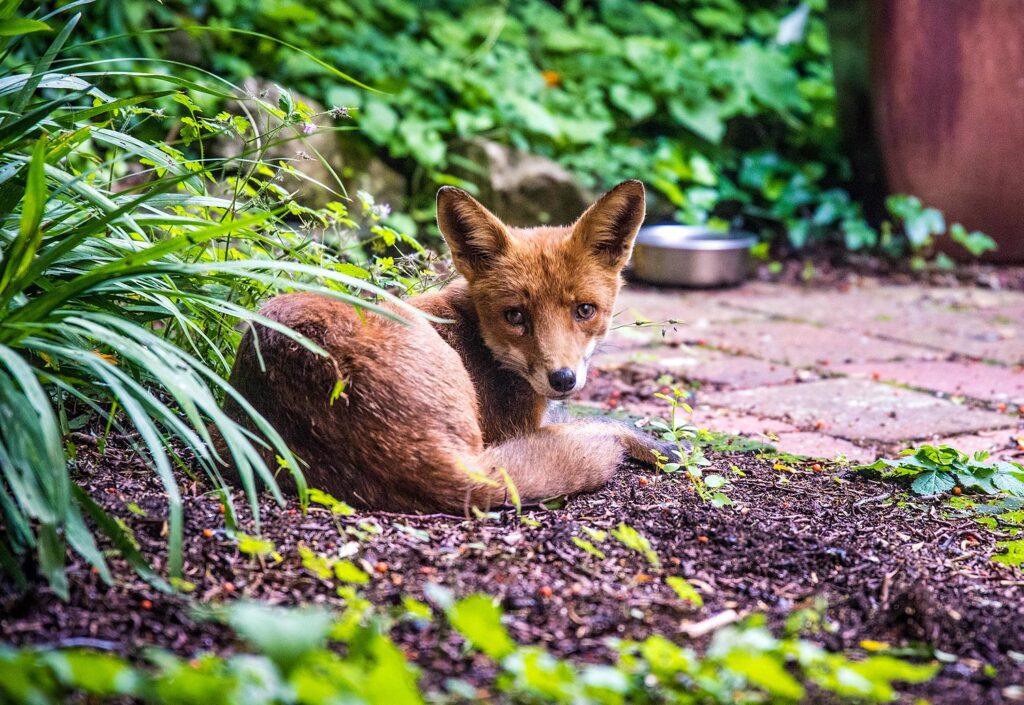
Bold Fox now sits in the garden and simply abides with me, completely relaxed and happy to be in my presence. To me, this is clearly a touching demonstration of trust.
Further reading
If you want to know more about the red fox then I recommend this extensive resource:
Further thoughts – October 2023
I wanted to make an addition to this page to address the question of whether providing food for foxes makes them more likely to approach any other human, attention that may not always be welcome.
My experience with Bold Fox suggests otherwise. Firstly I’d say that the better I’ve come to know Bold Fox the more apparent it becomes just how intelligent and perceptive he is. I suspect this is true of most foxes.
I had been concerned about desensitising him to the potential risk presented by humans, or at least those ones who (inexplicably to me) harbour a problem with the urban fox. But my experience now indicates that this isn’t the likely outcome. Still, this concern is one of the reasons why I’ve never tried to stroke or hand feed him, although that choice also stems from a respect for his wildness and recognising that trying to pet him would somehow be to cross a line. Nonetheless, we have become comfortable and at ease with each other.
What has become clear though is that the relationship I’ve developed with Bold Fox is very much between him and me. That is, he has come to recognise and trust me, specifically. This has been clearly demonstrated by recent attempts to introduce him to my wife. Even though she’s there beside me, and obviously trusted by me, Bold Fox will still flee at the sight of her. I would like him to come to know my wife better, but it’s apparent this will be a long-term ambition. There’s no evidence that he has developed an automatic acceptance of humans, even when an unfamiliar human is accompanied by one he knows and trusts.
So I think such ideas underestimate the intelligence of the fox. I’d argue they’re perfectly capable of deciding who they should trust and they remain extremely cautious of those they don’t know. And, as I can attest, if you’re lucky enough to be trusted by a fox then that is quite a special thing.


